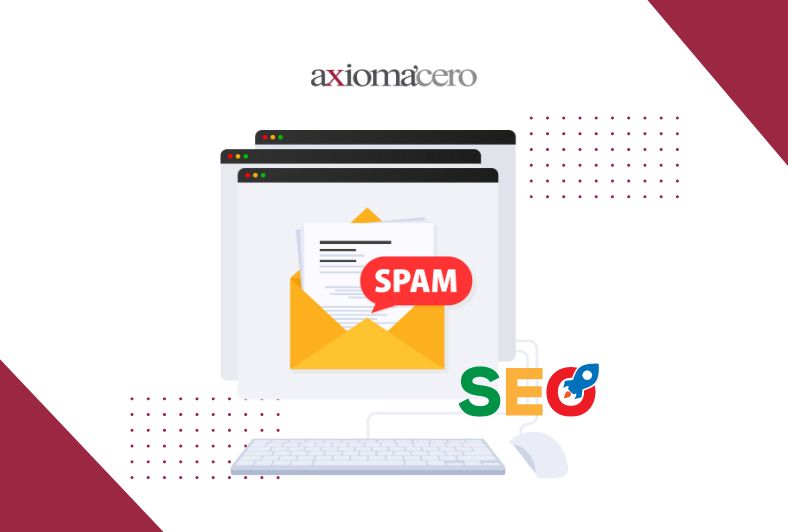What is SEO Spam?

In SEO, the term “spam” has acquired a particular and negative connotation.
SEO SPAM REFERS TO DISHONEST OR MANIPULATIVE PRACTICES AIMED AT IMPROVING A WEBSITE’S RANKING IN SEARCH ENGINES UNETHICALLY.
These practices can not only damage a website’s reputation but also result in severe penalties from search engines like Google.
What is SEO Spam?
SEO spam includes a variety of techniques that attempt to deceive search engines to achieve a better ranking in search results.
These practices go against the guidelines established by search engines and can have long-term negative consequences.
Types of SEO Spam
- Keyword Stuffing: involves excessively and unnaturally filling a webpage with the target keyword. This practice tries to manipulate rankings by making search engines believe that the page is more relevant to the user’s query than it is.
- Cloaking: is a technique where different content is shown to search engines than to users. This is done to deceive search engines about the actual content of the website.
- Link Farming: involves creating multiple links between websites to artificially inflate the number of inbound links. Search engines value inbound links as a sign of a website’s authority and relevance, but when these links are unnatural, it can result in penalties.
- Duplicate Content: is another type of SEO spam. It refers to the exact copying of content from other websites, which does not provide unique value to users and can harm the user experience.
Consequences of SEO Spam
- Penalties from Search Engines: like Google have sophisticated algorithms that can detect SEO spam. When these practices are detected, the website can be penalized, which can include a drop in rankings or even complete removal from search results.
- Loss of Credibility and Reputation: Users value transparency and quality content. A website that resorts to spam techniques can lose the trust of its users, which can have a negative impact on the brand in the long term.
Strategies to Avoid SEO Spam
- Creating Quality Content: is fundamental to a successful SEO strategy. Search engines value original, relevant, and useful content that answers users’ queries.
- Proper Use of Keywords: should be integrated naturally into the content. Excessive and forced use of keywords can be perceived as spam by search engines.
- Building Organic Links: Link building should be organic. This involves obtaining links from relevant and high-authority websites naturally, rather than resorting to link farms or unethical practices.
- Optimizing for User Experience: Website optimization should focus on improving the user experience. This includes enhancing site speed, ease of navigation, and content relevance.
Integration of SEO and Digital Marketing
Practical Tips and Advice
- Keyword Research Conduct thorough keyword research. Use tools like Google Keyword Planner, Ahrefs, or SEMrush to identify relevant keywords that can attract quality organic traffic.
- Content Optimization for SEO Every piece of content should be optimized for SEO. This includes using attractive titles, meta descriptions, appropriate headings and subheadings, and incorporating internal and external links.
- Link Building Strategies Develop ethical and sustainable link-building strategies. Collaborate with other high-authority websites and participate in relevant communities to obtain quality links.
- Continuous Monitoring and Analysis Use tools like Google Analytics and Google Search Console to monitor your website’s performance. Analyze the data to identify areas for improvement and adjust your SEO strategy accordingly.
FAQs about SEO Spam
- How can I know if my website has been penalized for SEO spam? You can use Google Search Console to check if your website has received a penalty. Google usually notifies webmasters about manual actions taken against their sites.
- Is it possible to recover a website penalized for SEO spam? Yes, it is possible. First, you need to identify and remove the spam practices. Then, request reconsideration from Google through Google Search Console.
- How long does it take to recover a penalized website? The recovery time can vary. It depends on the severity of the penalty and how quickly corrective actions are implemented. It can take from a few weeks to several months.
SEO spam is a dishonest practice that can have serious consequences for a website’s visibility and reputation. It’s essential to adhere to SEO best practices and focus on creating quality content, building organic links, and optimizing for user experience. Doing so builds a solid foundation for long-term success in digital marketing.
We invite you to visit our website for more information on how we can help you improve your SEO strategy: Axiomacero.
Also, follow us on our social media to stay updated with the latest trends and tips in SEO. Join our online community and participate in the conversation!